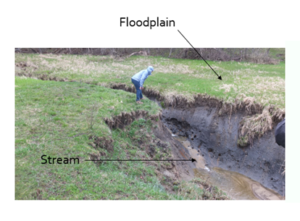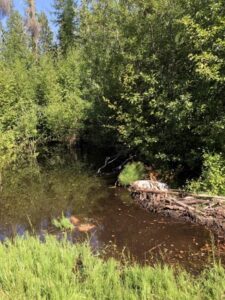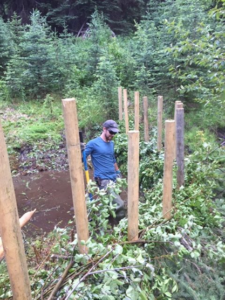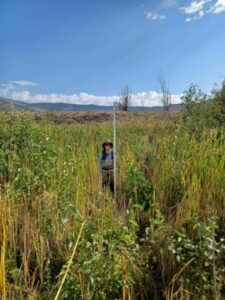By Katelin Killoy, Rebecca Brown, and Camille McNeely
This summer a team from EWU’s biology department and partners from the Methow Beaver Project collected data from 13 streams across the Methow and Okanogan watersheds. We focused our efforts on incised streams in wildfire affected areas. Stream incision occurs when channel downcutting into the stream bed causes streams to be disconnected from their floodplain, so water storage and riparian zones become diminished (Figure 1). This means that floodplains no longer become flooded, and important nutrient exchanges and channel forming floods do not occur. Additionally, when streams are disconnected; floodplains begin to resemble dry upland terraces. Stream incision often occurs from the loss of vegetation on banks, due to wildfires, grazing, etc., leading to high erosion. Wetland vegetation decreases, runoff into streams increases, channel downcutting increases, nutrient retention decreases, and water storage decreases. This is often compounded by the loss of beavers.

Figure 1: An incised stream. Look at how the stream and the floodplain are disconnected. This causes the floodplain to resemble dry uplands as you can see in the picture. This doesn’t look like a stable stream ecosystem fit for fish and wildlife.
Beavers increase water storage in incised streams by raising water levels in the stream and groundwater by creating dams. Water storage describes water that is temporarily held in the area. Beaver dam complexes increase water storage by slowing water and increasing water infiltration into the soil. Raising water storage restores floodplain water tables by extending groundwater infiltration throughout the floodplain. When beaver dams store precipitation and snowmelt longer, they can relieve drought stress and allow more floodplain and wetland plant species to grow. The resulting lush, wet floodplains provide important food for wildlife, and refugia during drought and wildfires. But that’s not all beavers do!
Beaver ponds improve water quality by trapping and converting nutrients (Figure 2). Increased runoff into streams can increase nitrogen and phosphorus concentrations in streams from fertilizers. When this happens, algae abundance increases from the high availability of nutrients. When the algae die, microbes decompose the algae, resulting in reduced dissolved oxygen in the stream, which can be very harmful for our native trout and salmon populations. Streams with beaver ponds have lower streambank erosion and contribute the least soil and phosphorus into streams. Additionally, the retention of phosphorus from beaver ponds help aquatic ecosystems recover from wildfires by trapping nutrients. There is a common belief that beaver ponds are not good for salmonids and ecosystems, but we are now discovering how beneficial they are.
Despite the many beneficial ecosystem functions beaver dams provide, beavers are not found in many of their historic watersheds. Human conflict, trapping, and degraded floodplains prevent them from reaching their historic population levels. While beaver reintroduction may help restore streams, there are areas where reintroduction may not be feasible or may require prior floodplain restoration to ensure the habitat is viable for beavers.

Figure 2: Beaver pond on Benson Creek in the Methow watershed. You can visually see how the dam is storing water, and the dam is surrounded by lush vegetation.

Figure 3: A crew from the Methow Beaver Project building a Beaver Dam Analog. They hammer in posts across the stream and then weave trees such as willows or alder through the posts. These are designed to mimic natural beaver dams.
Where beaver reintroduction is not feasible, Beaver Dam Analogs (BDAs) may be a useful tool (Figure 3). BDAs are man-made structures mimicking beaver dams. Although, they are maintained less frequently and often use more porous materials, it is not known how effective BDAs are at mimicking natural beaver dam ecosystem functions. The few existing BDA studies have low replication, and are usually based on one BDA complex. Yet despite the limited research on their efficacy, BDAs have become an increasingly popular restoration tool.
To address the need for more research, I am conducting a large-scale study of multiple BDA and beaver dam complexes in the Methow and Okanogan watersheds funded by a grant from Seattle City Light to my mentors, Dr. McNeely and Dr. Brown. Our study is making use of eight BDA complexes being established by the nonprofit, Methow Beaver Project, with over a million dollars in funding from the Washington Department of Ecology and the Wildlife Conservation Society. Last summer, we collected data on topography, vegetation, water quality, and water storage (Figure 4 and 5) before the BDA complexes were installed, and next summer I’ll be collecting data after installation. Our study will be the first step of a long-term study assessing BDA success over time, and will help guide agencies’ use of BDAs as a restoration technique. My study will determine whether BDAs can play a similar role to Beaver dams in increasing ecosystem resilience to climate change induced drought and wildfire.

Figure 4: Graduate student Katelin Killoy holding a stadia rod to measure topography at a beaver pond on Bonaparte Creek in the Okanogan Watershed. Look at how green the floodplain is.

Figure 5: Undergrad field technician Catie Schwartzmann, and Dr. Rebecca Brown conducting a vegetation transect across Tunk Creek in the Okanogan Watershed. This is a future BDA complex site. Pre-restoration data was being collected. Look at the stream incision.